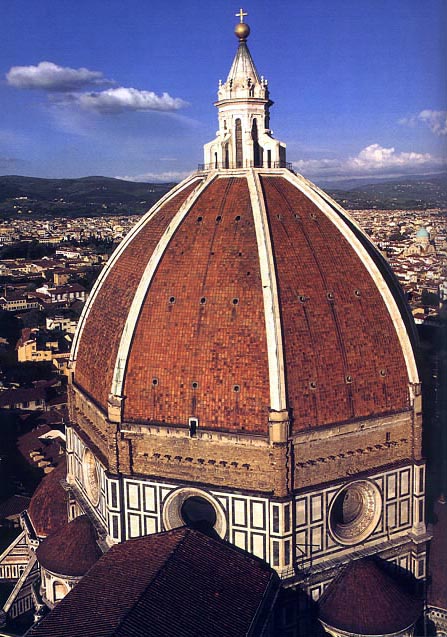| Deborah Stott | Letter from Florence, 13 July 1997 | |
|
Tuscan countryside
Florence Cathedral
|
This past week I went down to Florence for a few days, mainly to go to the Buonarroti archives in the Casa Buonarroti, the townhouse/palace built on the site of some houses originally bought by Michelangelo but then much enlarged by his grandnephew. All of the letters to and from Michelangelo and members of his family (the ones that exist anyway) and all of the bits of paper that he saved and that were then saved by his nephew and heir (the ricordi) are there, neatly bound into many volumes. I was going in particular to look at Cornelia's letters, just to see them in person and to try to determine whether she had written them herself. A friend had told me that the archive personnel were somewhat reluctant to let people actually handle the materials, but, as in Urbania, the staff responsible couldn't have been nicer or more helpful. I had been asked to be sure to bring my documenti, letters of introduction, so when I arrived, I produced the deanís letter to demonstrate my official scholarly status and all was well. I was then ushered into a small room with bookshelves, a table with places for six people at most, and a couple of desks where staff was working. Intimate to say the least. Lest one be too intimidated by being in Michelangelo's "presence," two young people (staff, I think) were working on some posters with drawings by children after works by Michelangelo. Since the letters are all published, I had the precise references to ask for, but there was also a wonderful index, probably 19th century, with summary listings of everything in each volume, which was very helpful. So I got my volume with Cornelia's letters, opened it (having been issued white gloves in order to be able to touch the originals) and saw immediately that they were in various handwritings, so it is unlikely she herself could write. I spend the morning looking carefully at each one and comparing the hands and my very inexpert opinion is that there are six different hands, including that of her second husband, who wrote almost all of them after they were married. The majority of the rest are in one hand, but there are also four other hands. And all of the signatures are in the same hand as the body of the letter. I don't believe that this makes the letters any less "hers," at least the ones written before her remarriage, but it does have to be taken into account. And it was still neat to actually handle the letters themselves. The next morning, I looked at some other material, including some documents that aren't, as far as I know, published, including a notary's official certification that Cornelia had attested that her husband had received certain monies due him on account of her dowry. There is a letter from her husband to Michelangelo in which he apologizes for not having gotten this document to him before - since apparently Michelangelo had asked for it - but he has been away from home working for the Duke of Urbino and hasn't been able to. So he has, he says, asked Cornelia ("la mia Cornelia") to have one sent and that is just what she did and this is the copy that was sent to Michelangelo. In fact, on the outside of the document is the notation that Cornelia had this document prepared. I'm getting photographs of this and several of the letters. There is also Michelangelo's official receipt for the shares in the Monte della Fede, the papal fund, that he bought with the first husband's estate in the name of his heirs, Cornelia's two sons. And also his copy of the contract of sale by which Cornelia and the other executors bought a farm in Casteldurante for these heirs, using the money Michelangelo had turned over by cashing in these funds. There are several letters about this transaction and in them Cornelia always says that she has sent him the contract to look over and that when the sale is completed she will send him the final contract, and there it is. I have to say that, in addition to the pleasure of seeing original material, I had music. The reading room gives onto a tiny courtyard, in which rehearsal was going on for a vocal concert that evening, a soprano singing songs from Mozart and others. The staff kept apologizing for the noise and asking me if I wanted the windows closed, but I found it lovely. The second day was a little less lovely, since they were apparently conducting a kind of master class and not all of the singers quite kept on key. The assistant with whom I was working, Elena Lombardi, said that the custodian, whose apartment is also on the courtyard, was nearly ready to quit. |

